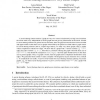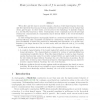110
Voted
CRYPTO
2012
Springer
13 years 3 months ago
2012
Springer
It is notoriously difficult to create hardware that is immune from side channel and tampering attacks. A lot of recent literature, therefore, has instead considered algorithmic de...
109
Voted
CRYPTO
2012
Springer
13 years 3 months ago
2012
Springer
We introduce a new definition of privacy called crowd-blending privacy that strictly relaxes the notion of differential privacy. Roughly speaking, k-crowd blending private saniti...
119
click to vote
CRYPTO
2012
Springer
13 years 3 months ago
2012
Springer
Abstract. We present the first black-box construction of a secure multiparty computation protocol that satisfies a meaningful notion of concurrent security in the plain model (wi...
114
click to vote
CRYPTO
2012
Springer
13 years 3 months ago
2012
Springer
A secret-sharing scheme realizes a graph if every two vertices connected by an edge can reconstruct the secret while every independent set in the graph does not get any informatio...
114
click to vote
CRYPTO
2012
Springer
13 years 3 months ago
2012
Springer
Liskov, Rivest and Wagner formalized the tweakable blockcipher (TBC) primitive at CRYPTO’02. The typical recipe for instantiating a TBC is to start with a blockcipher, and then b...
CRYPTO
2012
Springer
13 years 3 months ago
2012
Springer
101
Voted
CRYPTO
2012
Springer
13 years 3 months ago
2012
Springer
We present a compiler that converts any circuit into one that remains secure even if a constant fraction of its wires are tampered with. Following the seminal work of Ishai et al. ...
122
Voted
CRYPTO
2012
Springer
13 years 3 months ago
2012
Springer
We describe a working implementation of leveled homomorphic encryption (without bootstrapping) that can evaluate the AES-128 circuit in three different ways. One variant takes und...
101
click to vote
CRYPTO
2012
Springer
13 years 3 months ago
2012
Springer
We develop a new methodology for utilizing the prior techniques to prove selective security for functional encryption systems as a direct ingredient in devising proofs of full sec...
CRYPTO
2012
Springer
13 years 3 months ago
2012
Springer



